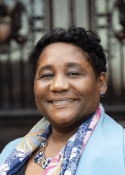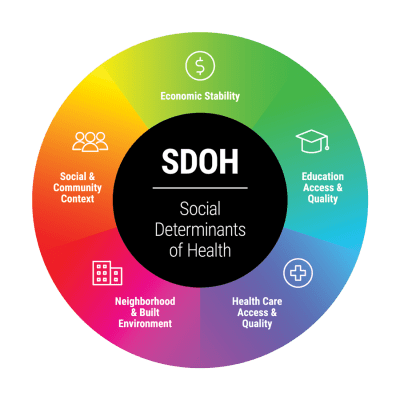RNs recount progress, challenges in meeting patients’ overall needs
In recent years, nurses and key policymakers have recognized that improving health requires attention to many aspects of people’s lives outside of healthcare settings. The COVID-19 pandemic laid bare the effects of social determinants of health (SDOH). Influential efforts such as the 2021 National Academy of Medicine report, Future of Nursing 2020-2030: Charting a Path to Achieve Health Equity, and the Department of Health and Human Services Healthy People 2030 initiative prioritized SDOH. More recently, in November 2023, the White House released a playbook for addressing SDOH.
Addressing SDOH isn’t new to nurses, said Roberta Waite, EdD, MSN, RN, PMH-CNS, ANEF, FAAN, dean and chief nursing officer at Georgetown University School of Nursing. “Nursing has been paying attention to these specific issues that influence health almost since the beginning of the profession,” she observed.
The American Nurses Association (ANA) applauded Future of Nursing 2020-2030 when it was published, and its foundational documents such as the Code of Ethics for Nurses with Interpretive Statements (the Code) and Nursing: Scope and Standards of Practice call on nurses to integrate principles of social justice into nursing and health policy, respect the inherent dignity and worth of every person, advocate for patients’ rights, health, and safety, and protect human rights. The ANA Enterprise Strategic Plan supports and engages ANA members as thought leaders and activists in advancing the understanding of and responses to SDOH.
Delivering health equity at the bedside
Nursing and the evolution of population health
Medication adherence in underserved populations
Before and after healthcare






Waite, a Virginia Nurses Association member, noted many factors that affect health. Among them are racism, socioeconomic status, poverty, and access to clean air, water, and transportation. Employment, education, health insurance, sufficient healthy food, healthy neighborhoods and environments, economic stability, and community support also are included among SDOH.
These factors play a prominent role in common patient care scenarios, such as lack of adherence to insulin and other diabetes drug regimens, said Marcus Henderson, MSN, RN, a PhD candidate, and Zamoiski endowed doctoral fellow at the Johns Hopkins University School of Nursing. Helping people with diabetes, he stressed, means understanding the personal, interpersonal, environmental, and social factors that impact them. “It’s not as simple as telling patients they have diabetes, take this medication, follow this certain course of treatment,” he said. “You have to understand what happens at home. Does the patient have a refrigerator for insulin? Does the patient actually eat three meals a day?” A fellow of the Minority Fellowship Program at ANA and a past ANA Board of Directors member, Henderson also served on the consensus committee that wrote Future of Nursing 2020-2030.
Another common scenario involves unsheltered patients with congestive heart failure, said Danisha Jenkins, PhD, RN, CCRN, NEA-BC, NHDP-BC, assistant professor at San Diego State University School of Nursing. These often elderly individuals, many of whom also have diabetes, may well have nowhere to sit and elevate their legs or weigh themselves, according to Jenkins, a board member of ANA\California, member of ANA’s Center for Ethics and Human Rights Advisory Board, and a leader of the ANA\California San Diego Regional Task Force, which addresses SDOH in the community. “We stabilize them in the hospital but discharge them to the street to have their condition worsen and see them pop right back into the hospital in worse condition,” she noted.
In school settings, parents face challenges in getting healthcare for their children, said Tricia Howard, MSN, MHA, a North Carolina Nurses Association member and lead nurse and clinical supervisor for Durham (NC) Public Schools. For instance, they might not have a telephone, health insurance, transportation to appointments, or the ability to take time off from work or pay for housing.
The root of problems
Waite, Henderson, Howard, and Jenkins pointed to core causes of deficiencies in SDOH.
Waite called out racism. “Quality education, employment, safe neighborhoods, and just opportunities are due to how things are structured based on racialization of the population,” she observed. “So racist policies really have contributed significantly to many health inequities and social determinants of health.”
She noted that the COVID-19 pandemic was worse among populations subject to racism. Many Black and Brown populations couldn’t socially isolate because of their housing and employment situations. Also hit hard were people with low incomes, who lack housing, or who are part of sexual and gender minorities. School and business closures exacerbated food insecurity and income inequality.
Waite called on nurses to remember that social justice is a core tenet of ANA foundational documents, including the Code and Scope and Standards of Practice.
Henderson noted that the healthcare payment structure doesn’t encourage focus on SDOH. Currently, acute care reimbursement policies roll nursing care into room charges, creating a monetary disincentive for paying attention to what happens to patients outside of the hospital. He pointed to an ANA initiative that encourages nurses to apply for a national provider identifier (NPI) number—the gold standard for identifying and reimbursing healthcare. ANA considers these numbers a first step toward direct reimbursement for nursing services from Medicare and Medicaid. RNs and advanced practice RNs are eligible for NPIs, which remain valid when nurses move to other states.
Profit incentives in healthcare pose a huge barrier to improving SDOH, Jenkins emphasized. “It’s incredibly important that nurses address the ways in which both our profession and our healthcare system contribute to challenges that communities face. The reality is that when we have a profit-driven healthcare system, that system is built upon some folks not getting care,” she said. Jenkins added that making changes to this system will be difficult because it’s such a huge part of the U.S. economy.
The healthcare system also has a tremendous problem with trust among people of color and other marginalized individuals, according to Howard. She has witnessed her school families of color subjected to demeaning tones of voice and lack of eye contact from staff in healthcare settings. “If you’re going to do an assessment for social determinants of health, but you don’t really make me feel good about myself, I’m not going to disclose anything to you. [In this circumstance] any money put into SDOH is for naught,” Howard said.
She urged nurses to guard against implicit bias, noting everyone is guilty of it at some point. Countering implicit bias requires fostering a constant awareness of feelings toward patients and not letting it affect care. For example, if a nurse is a victim of domestic violence and must care for an abuser, that nurse should note their attitudes and feelings toward that individual and ask to be removed from the case or ask another nurse to step in and perform the assessment, if possible. “We need to bring awareness to the blind spots in ourselves,” Howard said.
Efforts on the ground
Gauging progress on SDOH and the Future of Nursing 2020-2030 poses challenges, Henderson said. He personally sees some progress on a recommendation that nurses be involved in technology that aims to improve SDOH and health equity.
One such example is an app co-developed by Robin Austin, PhD, DNP, DC, RN-BC, FAMIA, FNAP, an assistant professor at the University of Minnesota School of Nursing and Minnesota Nurses Association member. This tool, MyStrengths + MyHealth, a personal health assessment app, gives patients a voice in their healthcare by encouraging mental healthcare, social connections, good sleep habits, nutrition, and access to medicine and care. Typically, healthcare documentation is a nurse’s interpretation of what patients say, explained Austin, who won an ANA Innovation Award in 2023 for this work. “As a nurse, I might see something totally different or something I missed. We’re thinking of this app as potentially helping to change the clinical conversation.”
Future of Nursing 2020-2030 highlighted the American Academy of Nursing Edge Runners program, which supports scaling and replication of nurse-designed models of care that reduce cost, improve healthcare quality, advance health equity, and enhance consumer satisfaction.
The report noted that these models define health holistically, emphasize relationships with patients, and focus on underserved populations. For example, 2023 Edge Runner programs provide telehealth support to caregivers and infants during the difficult period of transition from neonatal intensive care to home, enhance school-based health services, and help nurses build trusting relationships with patients as they support patients in navigating the healthcare system.


Addressing SDOH requires nurses to work well with other professions to get patients’ non-healthcare related needs met, Howard and Henderson said. The Penn Futures Project, a collaboration among three professional schools at the University of Pennsylvania (graduate school of education, nursing, and social policy and practice), involves students in all three disciplines to address a specific social problem. Penn Futures Project also helps graduate students learn what the other disciplines do and later work with them in professional settings, Henderson said.
Howard pointed to multidisciplinary efforts in Durham, NC, such as Lincoln Community Health Center, which provides and coordinates care for patients without health insurance. The Community Health Coalition aims to eliminate health disparities, address medical problems common in underserved communities, and focus on food insecurity. During the pandemic, Duke University clinicians established Latin-19 to address health disparities within the Latina community resulting from the pandemic. Meanwhile, the African American COVID Taskforce Plus leveraged connections and knowledge about needs in the community to debunk myths about COVID-19 and how it spreads.
The ANA\California San Diego Regional Task Force focuses on mitigating challenges for unhoused people. Launched during a hepatitis outbreak ravaging the unsheltered population, the task force provided care and advocacy. One early focus included advocating for more public bathrooms, Jenkins noted. In 2020, task force members also tended to people injured at more than 100 protests after the murder of George Floyd. Since June 2023, the group has conducted evening and nighttime searches for unsheltered people wearing risk fall socks and wristbands, telltale signs of recent hospital discharge. The nurses examine discharge paperwork and make sure people have what they need to survive. After receiving grant funds, this effort is developing into a more sustainable program, Jenkins added.
She urged nurses to consider how they can take their skills “out of the hospital and into the streets.” Doing so involves realizing that a nurse’s work setting “is a small part of a very large story” and that problems within society and the health and economic systems contribute to patients’ health challenges.
Likewise, Henderson called upon nurses to remember their shared humanity with others and what all people need to flourish. “Everybody should have equal opportunity to thrive,” he emphasized. “What would you want for yourself and your family? Why can’t everybody have the same opportunities that you were afforded or that you want for your children and family in the future?”
Social determinants of health
Healthy People 2030 defines social determinants of health (SDOH) as the conditions in the environments where people are born, live, learn, work, play, worship, and age that affect a wide range of health, functioning, and quality-of-life outcomes and risks.
SDOH can be grouped into five domains: economic stability, education access and quality, health care access and quality, neighbor-hood and built environment, social and community context.
SDOH have a major impact on people’s health, well-being, and quality of life. Examples of SDOH include:
- Safe housing, transportation, and neighborhoods
- Racism, discrimination, and violence
- Education, job opportunities, and income
- Access to nutritious foods and physical activity opportunities
- Polluted air and water
- Language and literacy skills
Source: Healthy People 2030. Social determinants of health.
—Deborah Levenson is a professional writer.
American Nurse Journal. 2024; 19(4). Doi: 10.51256/ANJ042440
Resources
National Academy of Medicine. The Future of Nursing 2020-2030: Charting a Path to Achieve Health Equity.>nam.edu/publications/the-future-of-nursing-2020-2030
Online Journal of Issues in Nursing. Contemporary perspectives on poverty. January 31, 2024. ojin.nursingworld.org/topics/contemporary-perspectives-on-poverty/
Healthy People 2030. Social determinants of health. health.gov/healthypeople
Promote access to care at ANA’s advocacy website: RNAction.org
















